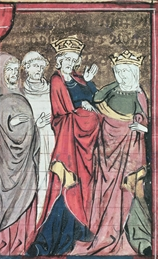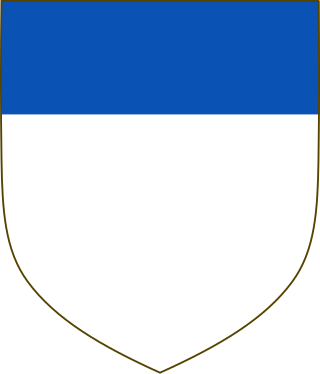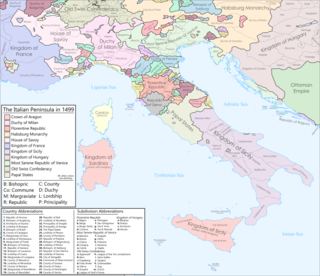
Saluzzo is a town and former principality in the province of Cuneo, in the Piedmont region, Italy.

Adelaide del Vasto was countess of Sicily as the third spouse of Roger I of Sicily, and Queen consort of Jerusalem by marriage to Baldwin I of Jerusalem. She served as regent of Sicily during the minority of her son Roger II of Sicily from 1101 until 1112.
William V of Montferrat also known regnally as William III of Montferrat while also referred to as William the Old or William the Elder, in order to distinguish him from his eldest son, William Longsword, was seventh Marquis of Montferrat from 1135 to his death in 1191. William was the only son of Marquis Renier I and his wife Gisela, a daughter of Count William I of Burgundy and widow of Count Humbert II of Savoy. It seems likely, given that he was still fit enough to participate in battle in 1187, that William was one of his parents' youngest children.

The Marquisate of Saluzzo was a historical Italian state that included parts of the current region of Piedmont and of the French Alps. The Marquisate was much older than the Renaissance lordships, being a legacy of the feudalism of the High Middle Ages.

Boniface del Vasto was the margrave of Savona and Western Liguria from 1084 to c.1130. He was the son and successor of Otto and of Bertha, daughter of Ulric Manfred II of Turin. Boniface was a member of the Aleramici dynasty.
Azalaïs of Montferrat (1150–1232) was marchioness consort of Saluzzo, and regent for her grandson, Manfred III from 1212 to 1218.
William VIII Palaiologos was the Marquis of Montferrat from 1464 until his death.
The March or Marquisate of Turin was a territory of medieval Italy from the mid-10th century, when it was established as the Arduinic March. It comprised several counties in Piedmont, including the counties of Turin, Auriate, Albenga and, probably, Ventimiglia. The confines of the march thus stretched across the Po Valley from the Western Alps in the north, to the Ligurian Sea.
William VII, called the Great Marquis, was the twelfth Marquis of Montferrat from 1253 to his death. He was also the titular King of Thessalonica.

The House of Aleramici were a medieval Italian noble family of Frankish origin which ruled various northwestern counties and marches, in Piedmont and Liguria from the tenth to the 14th centuries.
Boniface II, called the Giant, was the eleventh Marquis of Montferrat from 1225 until his death. He became the titular King of Thessalonica in 1239.

Anne d'Alençon, Lady of La Guerche, was a French noblewoman and a Marquise of Montferrat as the wife of William IX, Marquis of Montferrat. She acted as Regent of the Marquisate of Montferrat for her son, Boniface from 1518 to his death in 1530.
John Jacob Palaeologus was the Margrave of Montferrat from 1418 to 1445.
Manfred I, known as Manfredi Lancia, was the second Margrave of Busca, famous for his financial difficulties and his Occitan poetry. He was the first person to adopt the surname Lanza or Lancia, giving rise to the Lanza family.

The Marquisate of Ceva was a small independent state in north-western Italy, situated at the foot of the Apennines, with its seat at Ceva, in what is now a part of Piedmont.

The Marquisate of Finale was an Italian state in what is now Liguria, part of the former medieval Aleramici March. It was ruled for some six centuries by the Aleramici branch known as marquesses del Vasto and later Del Carretto, when Savona became a free commune. In 1598 the Marquisate was sold by its last marquis, Sforza Andrea to Philip II of Spain and in 1713 it was finally ceded to the Republic of Genoa, where it remained so until 1797, when it was invaded by Napoleon, ceasing its existence.
Ottone del Carretto, a patron of troubadours and an imperialist, was the margrave of Savona (c.1185–91) and podestà of the Republic of Genoa (1194–95) and of Asti (1212). He was the founder of the Del Carretto family.

The Ceva Grimaldi are an Italian noble family established in Southern Italy since the 16th century but whose origins are in Piedmont and Liguria and date back to the 10th century. The main titles associated with this branch of the Ceva family are Marchese di Pietracatella and Duca di Telese.









